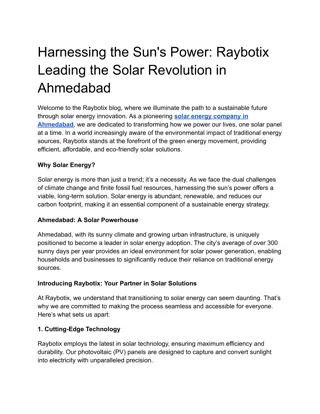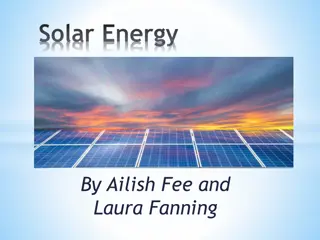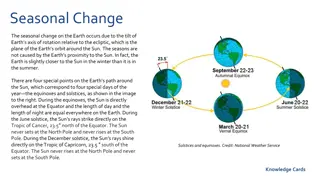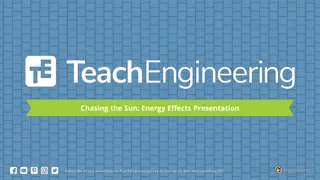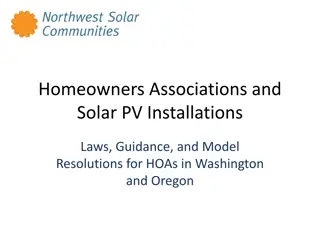Exploring Solar Energy to Meet U.S. Energy Needs
This presentation delves into the estimation of solar energy requirements to fulfill the energy needs of the United States. It covers the basics of energy and power, primary power use in the U.S., the significance of solar energy, and the components of a solar cell. The discussion includes the question of how many solar panels would be needed to power the U.S., highlighting the abundant, renewable, and environmentally friendly aspects of solar energy.
Download Presentation

Please find below an Image/Link to download the presentation.
The content on the website is provided AS IS for your information and personal use only. It may not be sold, licensed, or shared on other websites without obtaining consent from the author. Download presentation by click this link. If you encounter any issues during the download, it is possible that the publisher has removed the file from their server.
E N D
Presentation Transcript
Estimating solar energy requirements to meet U.S. energy needs: an outreach event Daniel Esposito,1 Vernon Alt2 1Columbia University 2Northrup Grumman Corporation
An Introduction to Energy and Power Energy is the capacity to do work and has the unit of Joules (J) Power is the rate of energy consumption or generation and has the unit of Watts (W), equal to one Joule/second. 20 mW 1.2 kW 1 GW 60 W
Primary Power Use in the U.S. 3,500,000,000,000 W = 3.5x1012 TW = 3.5 TW
Todays Question: How Many Solar Panels are Needed to Power the U.S.? D.) Alaska 1,507,000 km2 A.) Connecticut 13,000 km2 (5,000 mi2) B.) Virginia 102,000 km2 C.) Texas 684,000 km2 (588,000 mi2) (40,000 mi2) (267,000 mi2)
Photovoltaic Energy Conversion Light Electricity Load Solar Panel U.S. Energy consumption = 3.5 TW Area?
Why Solar Energy? 1. Solar is abundant
Why Solar Energy? 1. Solar is abundant 2. Solar is widely available across the globe
Why Solar Energy? 1. Solar is abundant 2. Solar is widely available across the globe 3. Solar is a renewable resource
Why Solar Energy? 1. Solar is abundant 2. Solar is widely available across the globe 3. Solar is a renewable resource 4. Solar is environmentally friendly. It does not emit green house gases or other pollutants while operating
Description of a Solar Cell 4 main components of a solar cell: 1. Semiconductor 2. front contact 3. back contact Sun light 4. wires (+) (-) Electricity
Measuring electrical power produced by a a solar cell Quantities to be measured 1. Voltage (units: Volts) 2. Current (units: Amps) 3. Area (units: cm2) Power = (Voltage) x (Current) [=] Watts Leads Multimeter
Calculating Required Area of Solar Panels: 1. Find electrical power from a single solar panel (Ps ) : Ps = (Voltage) x (Current) (unit: Watt) 2. Find number of Solar Panels required to get 3.5 TW: 3,500,000,000 ,000 Watts Number of Panels = (Power from 1 panel)x(6/24) 3. Find total area occupied by solar panels Total Area = (Number of panels) x (Area of 1 Panel)
How did you do??? Alaska Connecticut 13,000 km2 1,507,000 km2 (5,000 mi2) Virginia 102,000 km2 Texas 684,000 km2 (588,000 mi2) (40,000 mi2) (267,000 mi2)
Why Isnt Solar Energy More Prevalent? 1.$$$$$$$$$$ 2.Solar Intermittency 3. Efficiency Price trends in U.S., 1976-2009^ ^ J. Newman, J. Electrochem. Soc., 2012.
What is Electricity, and how do we quantify the energy/power in electricity? Electricity is the flow of negatively charged electrons Three major metrics to describe electricity: electron (-) (-) Power= Current x Voltage ? = ?? ? V (+) (+) 1. Voltage (V) Unit: Volt 2. Current (I) Unit: Amp 3. Power (P) Unit: Watt
What is Light? Light is made of photons The more photons being emitted by a light source, the brighter the light source appears, and the more power being released by the light source high low Power Power
How do we measure the power contained by Light? Detector 1. Brightness (B) unit: lux 2. Power, also known as Irradiance (PL ) unit: mW / cm2 PL = B/1,000 Flux meter
Primary Energy Use in the U.S. 3,500,000,000,000 W =60 billion light bulbs =3 billion toasters =4 thousand nuclear plants
How do we make Solar Panels more common Engineers (Chemical Electrical, Mechanical, Civil) Scientists (Chemists, Physicists, Biologists) Technicians & skilled workers Technology (Math & Science) Sustainable Energy Future Politicians Psychologists Sociologists Urban planners Economists Bankers Marketing Policy Business
2 MAJOR Problems with fossil fuels 1. Fossil fuels are non-renewable
2 MAJOR Problems with fossil fuels 2. Global Warming / Pollution Energy Fossil Fuels (Coal, oil, natural gas)
2 MAJOR Problems with fossil fuels 2. Global Warming / Pollution Energy Fossil Fuels (Coal, oil, natural gas)
Greenhouse Gas Effect Some outgoing light is trapped by the earth s atmosphere and warms turns it into heat Some light is radiated back into space by earth Much of the sun s radiation is absorbed by the Earth
One More Important Metric: Efficiency Light Electricity PL PPV
One More Important Metric: Efficiency Light Electricity PL PPV Conversion efficiency= PPV Power produced by the solar panel = Power from the sun or light PL
Electrical Loads Radio 80 mA Refrigerator 2 Amps small lights 20 mA











